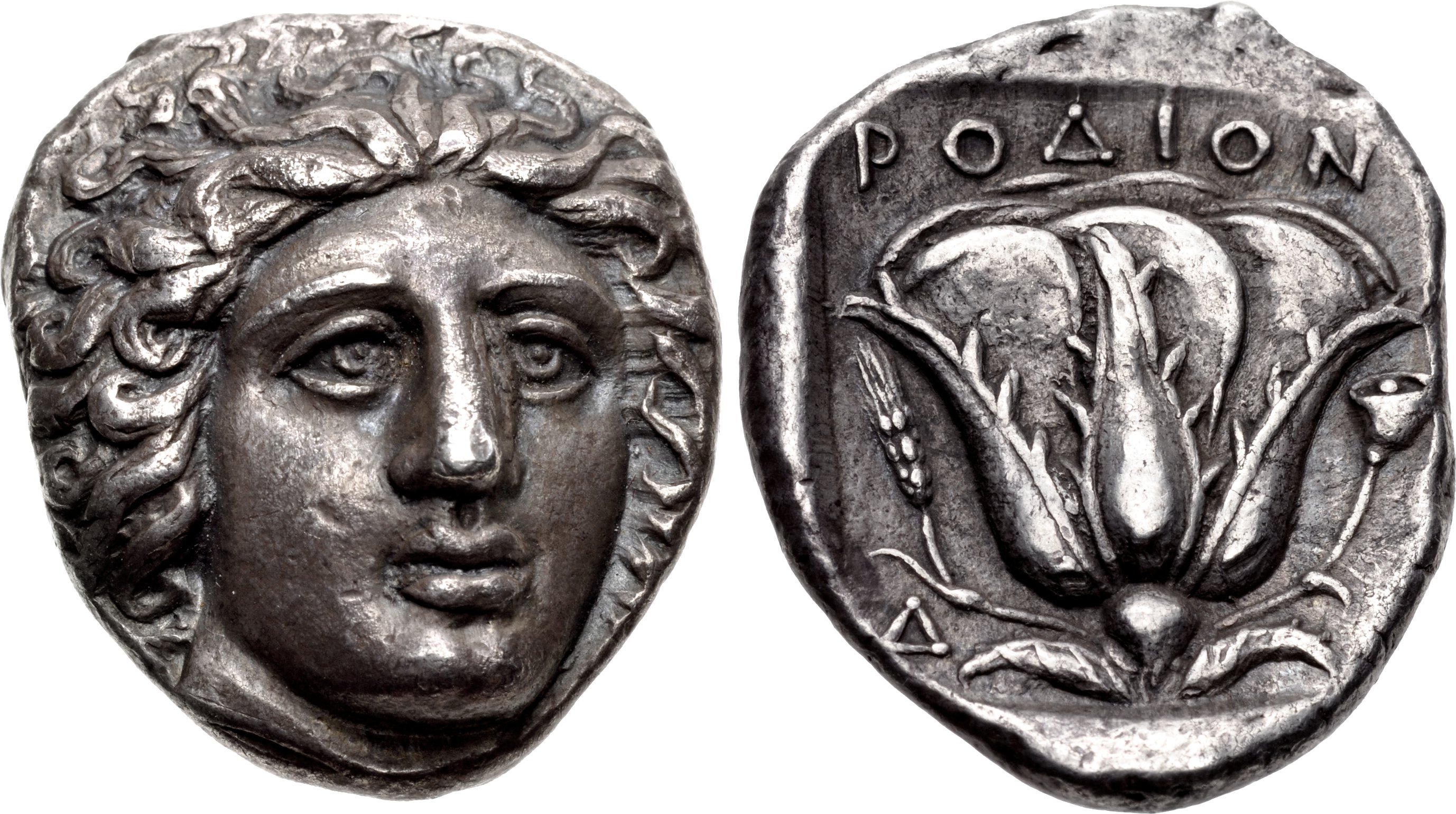Rhodes, silver, tetradrachms (408/7-385 BCE) Bérend
From SILVER
408 BCE - 385 BCE Silver 24,737 kg
Description
| ObverseInscription or printing placed on the obverse.: | Head of Helios facing slightly right |
| ReverseInscription or printing placed on the reverse.: | POΔION (Greek).Rose in profile, with grain ear 'budding' to left and rosebud to right, small Δ to lower left, all within incuse square |
Mint and issuing power
| MintIdentifies the place of manufacture or issue of a numismatic object.: | Rhodes | Ancient regionAncient region.: | Caria (islands) | Modern countryModern country: Greece | AuthorityIdentifies the issuing power. The authority can be "pretended" when the name or the portrait of X is on the coin but he/she was not the issuing power. It can also be "uncertain" when there is no mention of X on the coin but he/she was the issuing power according to the historical sources: | Rhodian power |
Chronology
| FromIdentifies the initial date in a range assigned in a numismatic context. | 408 BCE | toIdentifies the final date in a range assigned in a numismatic context.. | 385 BCE | PeriodTime period of the numismatic object.: Classical 480-323 BC |
Physical description
| MetalThe physical material (usually metal) from which an object is made.: | Silver |
Median weightMedian of the weights of numismatic objects (in grams). in grams | 15.10 | DenominationTerm indicating the value of a numismatic object. Examples: tetradrachm, chalkous, denarius.: | tridrachm |
StandardStandard.: | Rhodian |
Image

S1950 Rhodes tetradrachms.jpg [1]
References
| Die study referencePublication of the study: | Bérend 19721Bérend 1972 | ||
| Coin series referenceReference to coin series study: | Sear II2Sear II, n° 5029, RQEMAC3RQEMAC, n° 260, HGC 64HGC 6, n° 1418 | ||
| Coin series web referenceCoin series web references: | |||
Obverse dies distribution
| FrequencyFrequency of specimen in distribution. ᵖ | Number of obversesNumber of obverse dies. ᵖ (o) | % (o) | Number of coinsNumber of coins. (n) | % (n) | Die nameName(s) of the die(s). |
| 1 | 27 | 51.92 | 27 | 25 | 3, 5, 8, 10, 11, 12, 15, 16, 18, 20, 23, 27, 29, 31, 32, 33, 34, 39, 42, 43, 44, 45, 52, 56, 58, 64, 69 |
| 2 | 11 | 21.15 | 22 | 20.37 | 6, 7, 9, 21, 24, 28, 30, 37, 47, 49, 50 |
| 3 | 7 | 13.46 | 21 | 19.44 | 19, 26, 36, 38, 41, 60, 63 |
| 4 | 4 | 7.69 | 16 | 14.81 | 35, 46, 61, 62 |
| 5 | 1 | 1.92 | 5 | 4.63 | 48 |
| 7 | 1 | 1.92 | 7 | 6.48 | 14 |
| 10 | 1 | 1.92 | 10 | 9.26 | 13 |
| Total | 52 of 52 | 99.98 | 108 of 108 | 99.99 |
Reverse dies distribution
no distribution is available
Quantification
| Number of obversesNumber of obverse dies. ᵖ (o) | 52 | Number of singletons (o1)The number of singleton coins. ᵖ | 27 |
| Number of reverse diesNumber of reverse dies. (r) | Number of coinsNumber of coins. (n) | 108 | |
| Coins per obverse dieNumber of coins per obverse die. (n/o) | 2.08 | Coins per reverse dieNumber of coins per reverse die. (n/r) | |
| Reverse per obverse ratioRatio of obverse dies divided by reverse dies. (r/o) | Percentage of singletons (o1)number of coins (n) divided by the number of singletons (o1) ᵖ | 51.92 % | |
| Original number of dies (O) (Carter 1983 formula)The estimation of the number of coins according to Carter 1983 ᵖ | 81.91 | Coins struck if 20,000 as average productivity per dieCoins made if the average productivity for obverses (according to Carter) is 20,000. ᵖ | 1,638,200 |
| Original number of dies (O) (Esty 2011 formula)The estimation of the number of coins according to the singleton formula in Esty 2011 ᵖ (O) | 100.29 | Survival rate if 20,000 as average productivity per dieSurvival rate if average productivity is 20,000. ᵖ | 0.00007 |
| Coverage (o = % of O) (Esty 1984 formula)Esty 1984 - coverage (% of O) ᵖ (o = % of O) | 75% | Die productivity if survival rate 1/2,000Average productivity if survival rate is 1/2,000. ᵖ | 2,637.04 |
| Weight of silver (in kg) if 20,000 coins per die (O = Carter formula)Carter 1983 * Median weight * 20000 (*10 if gold or electrum) ᵖ | 24,737 kg <br /> 24,737 kg | Die productivity if survival rate 1/5,000Average productivity if survival rate is 1/5,000. ᵖ | 6,592.6 |
Remarks
Most likely one single workstation